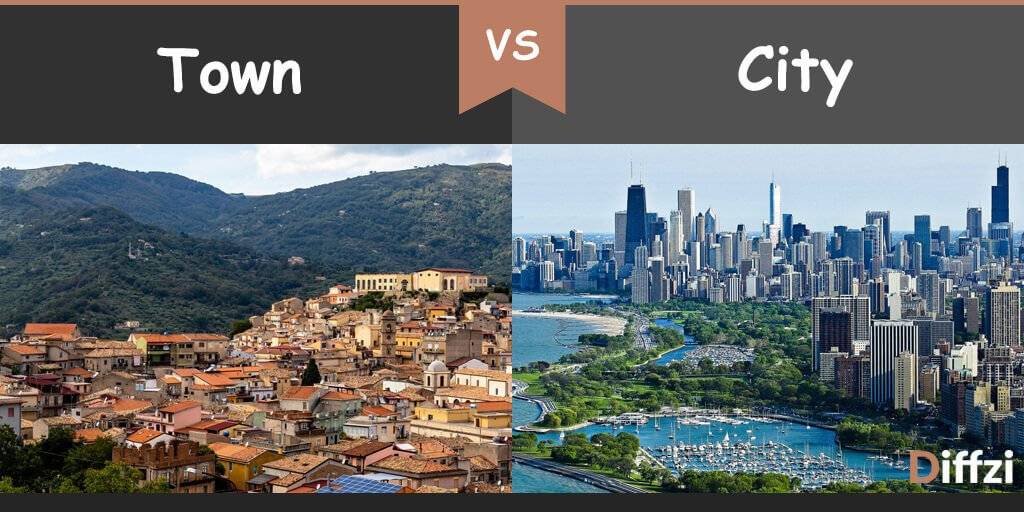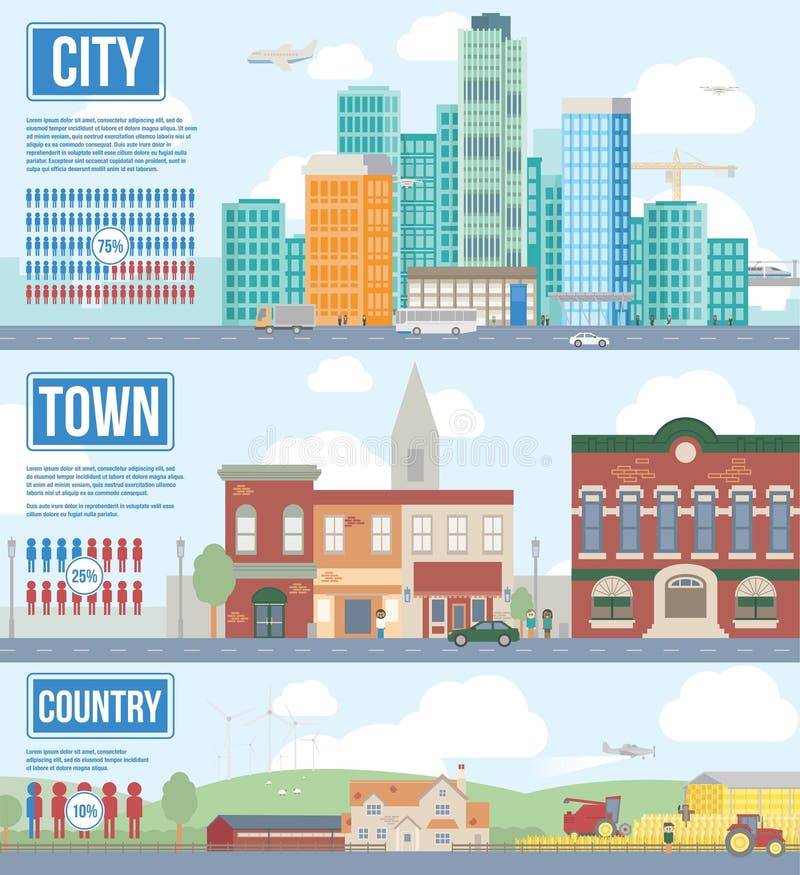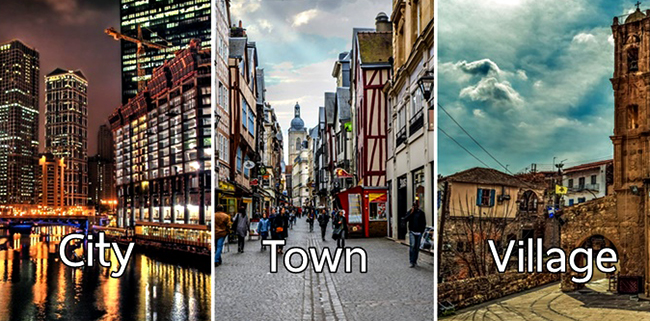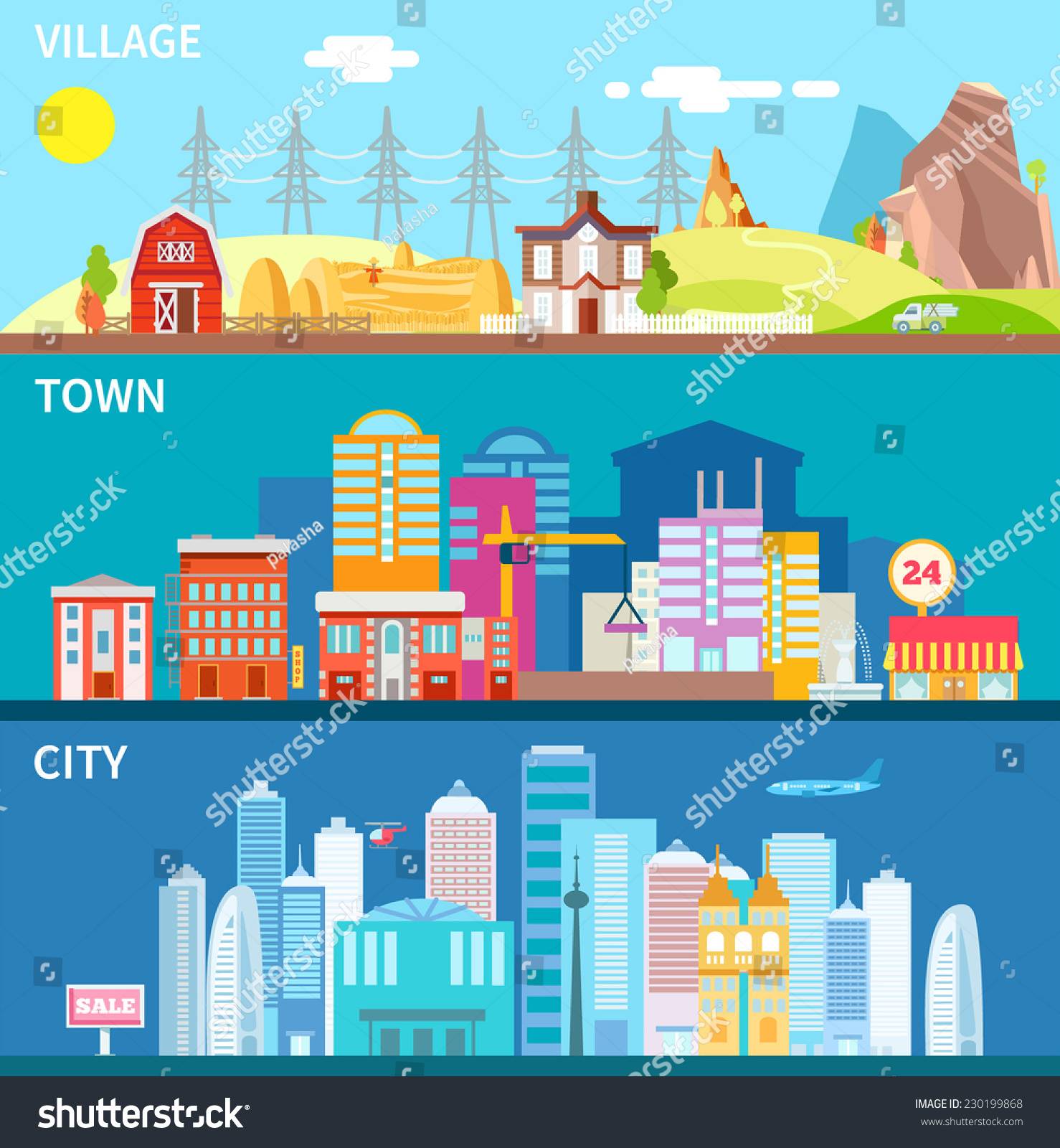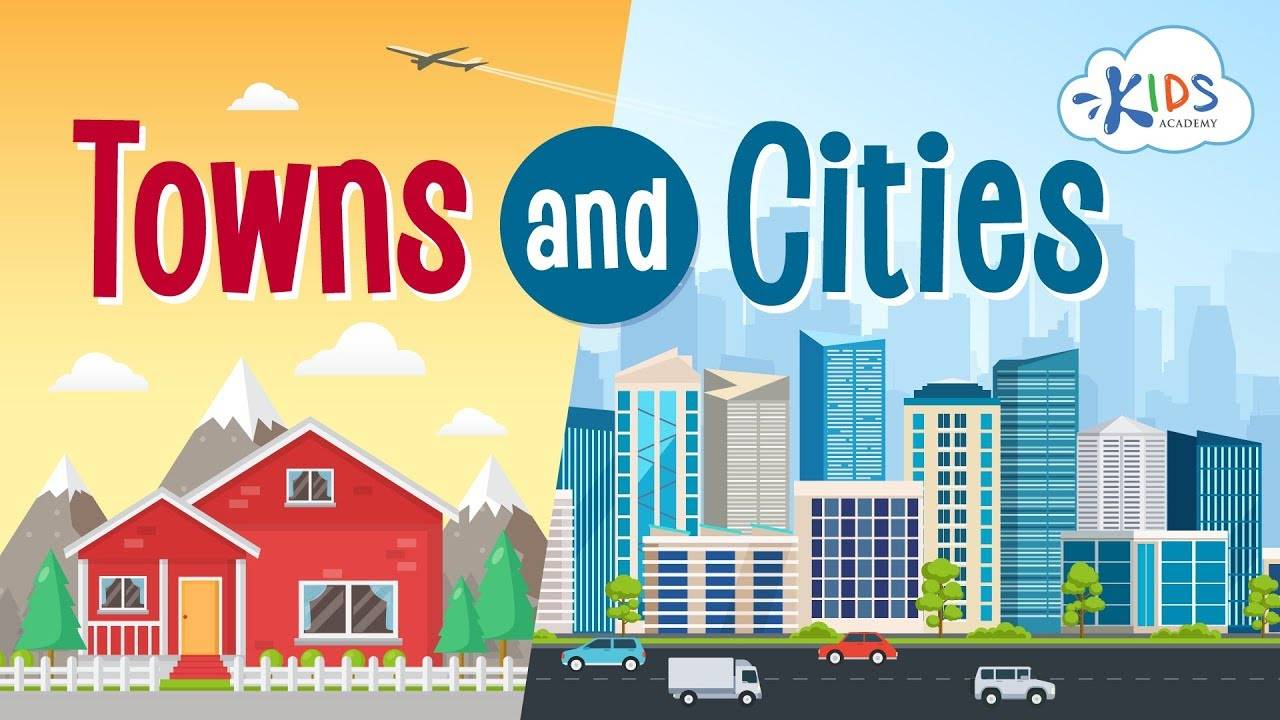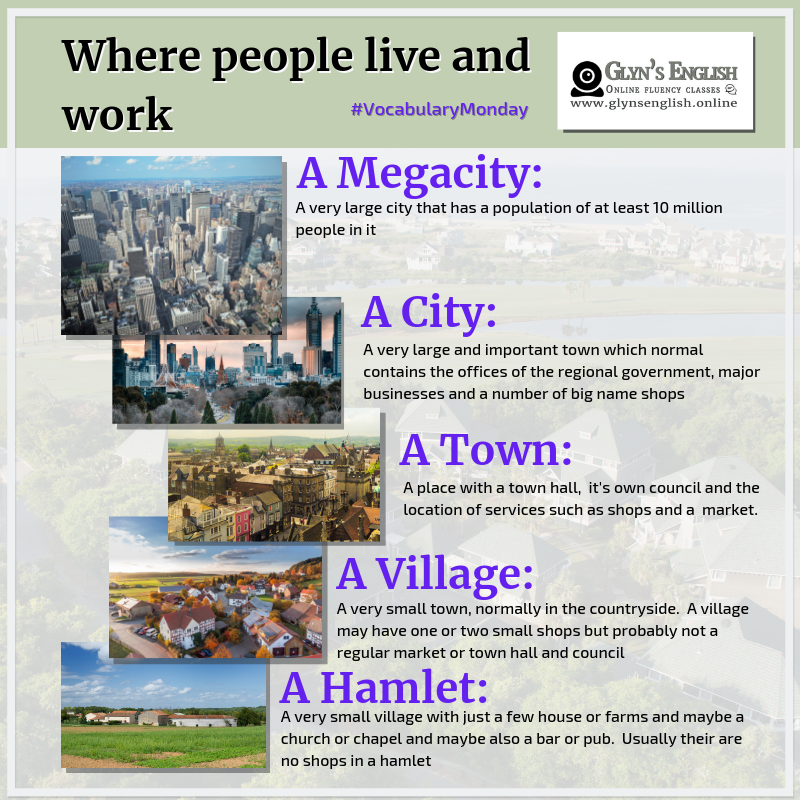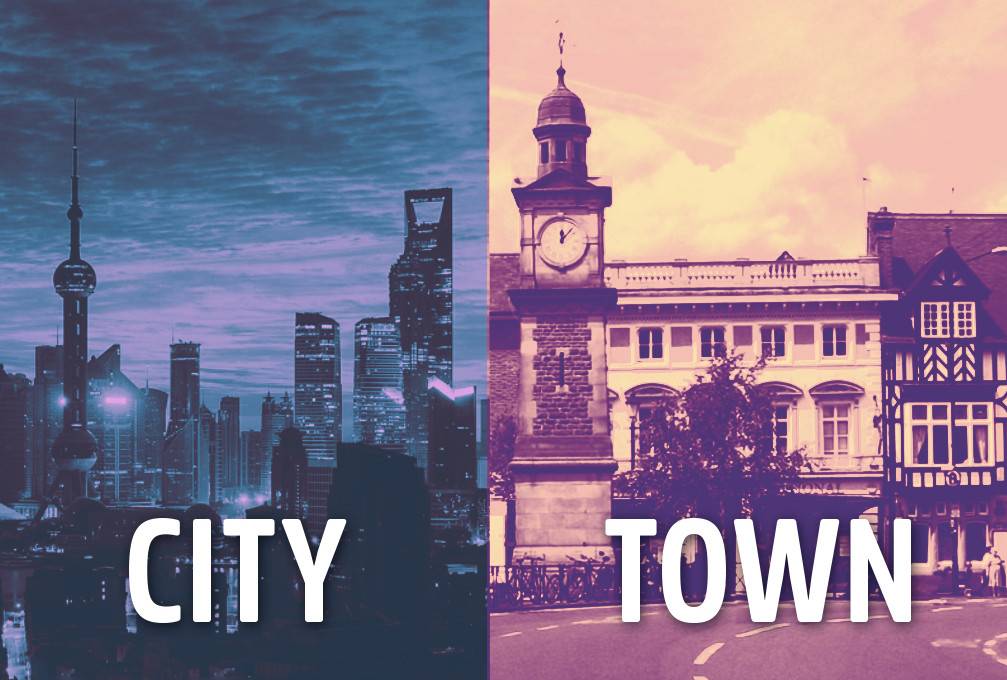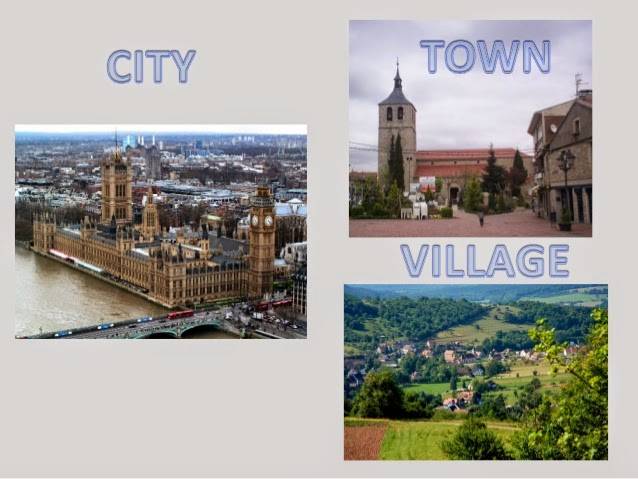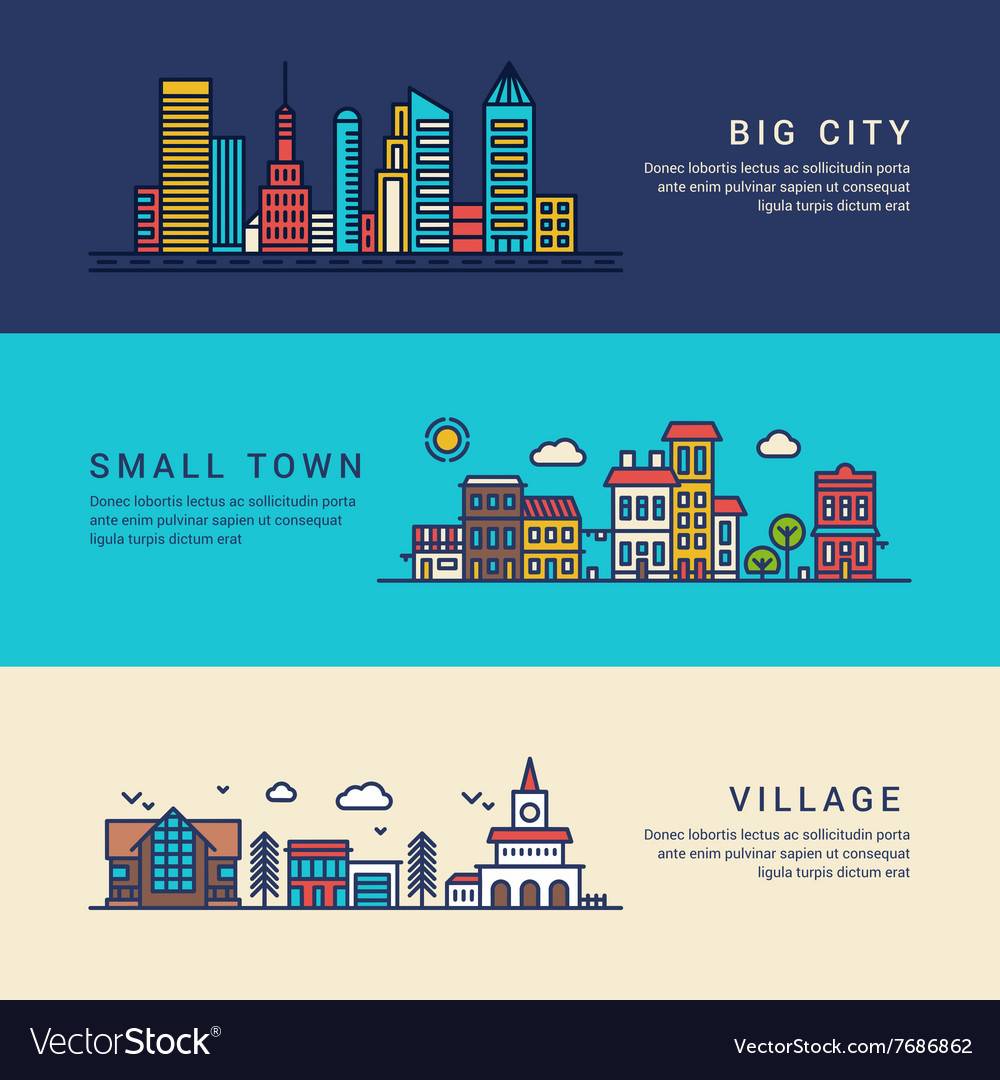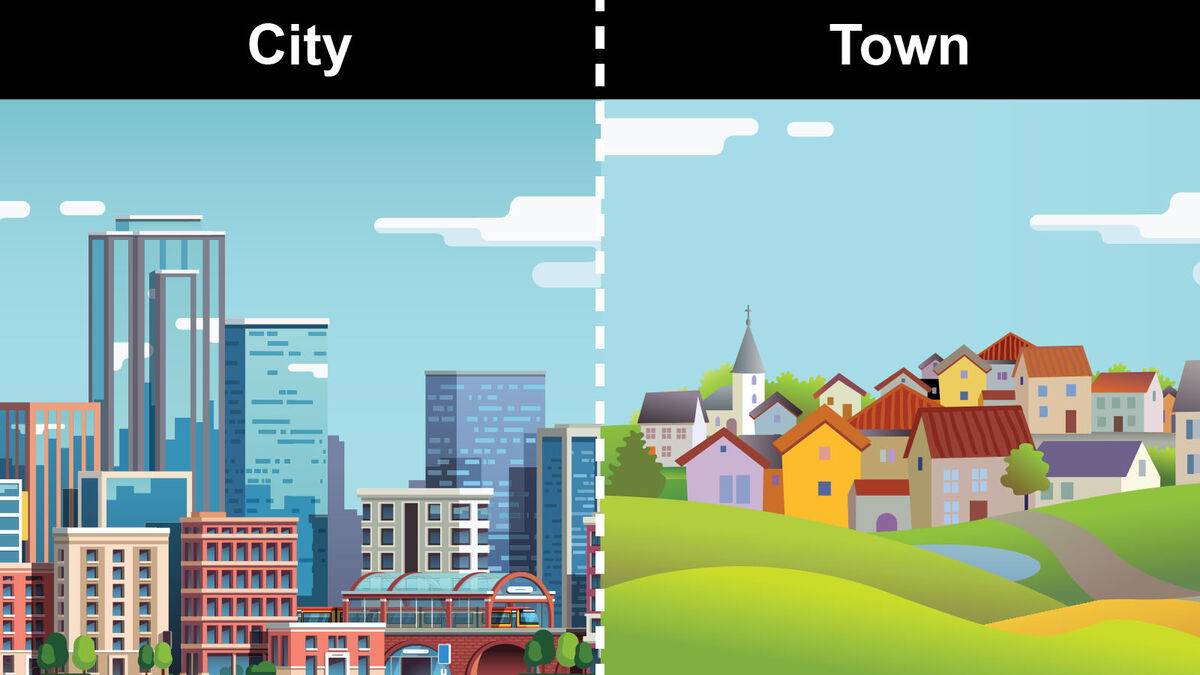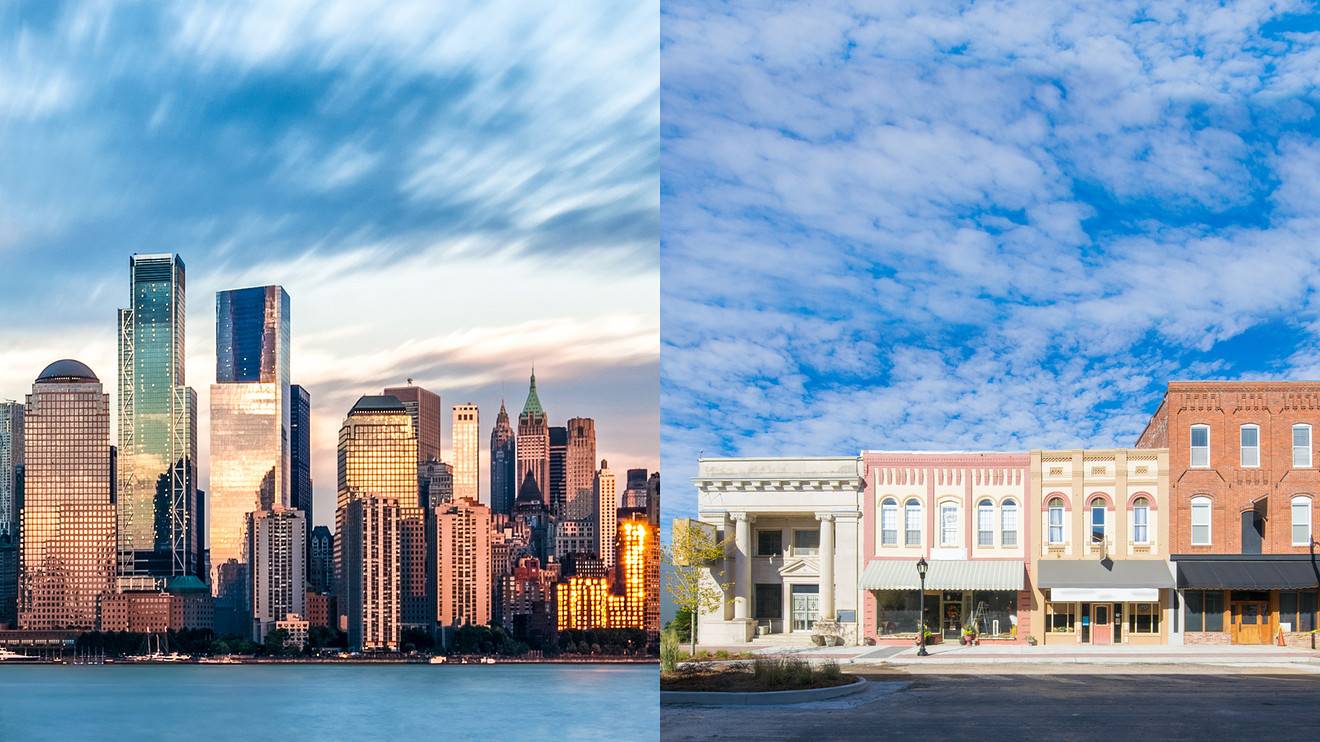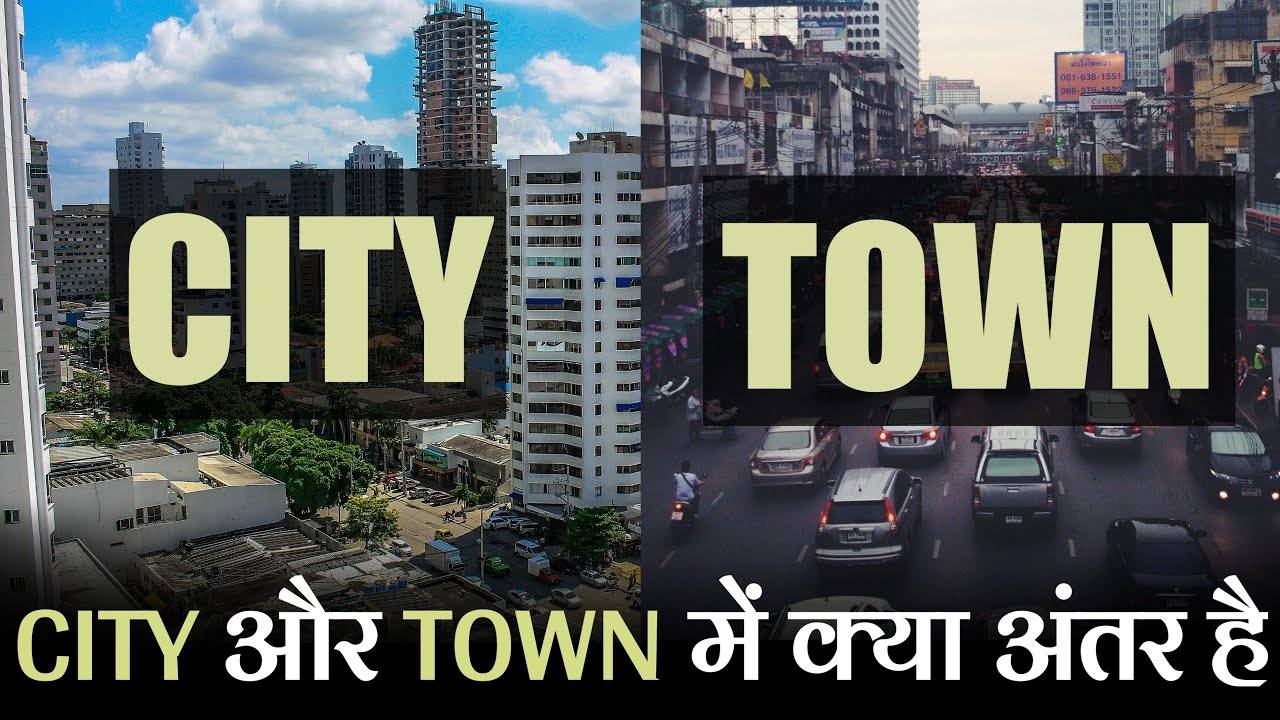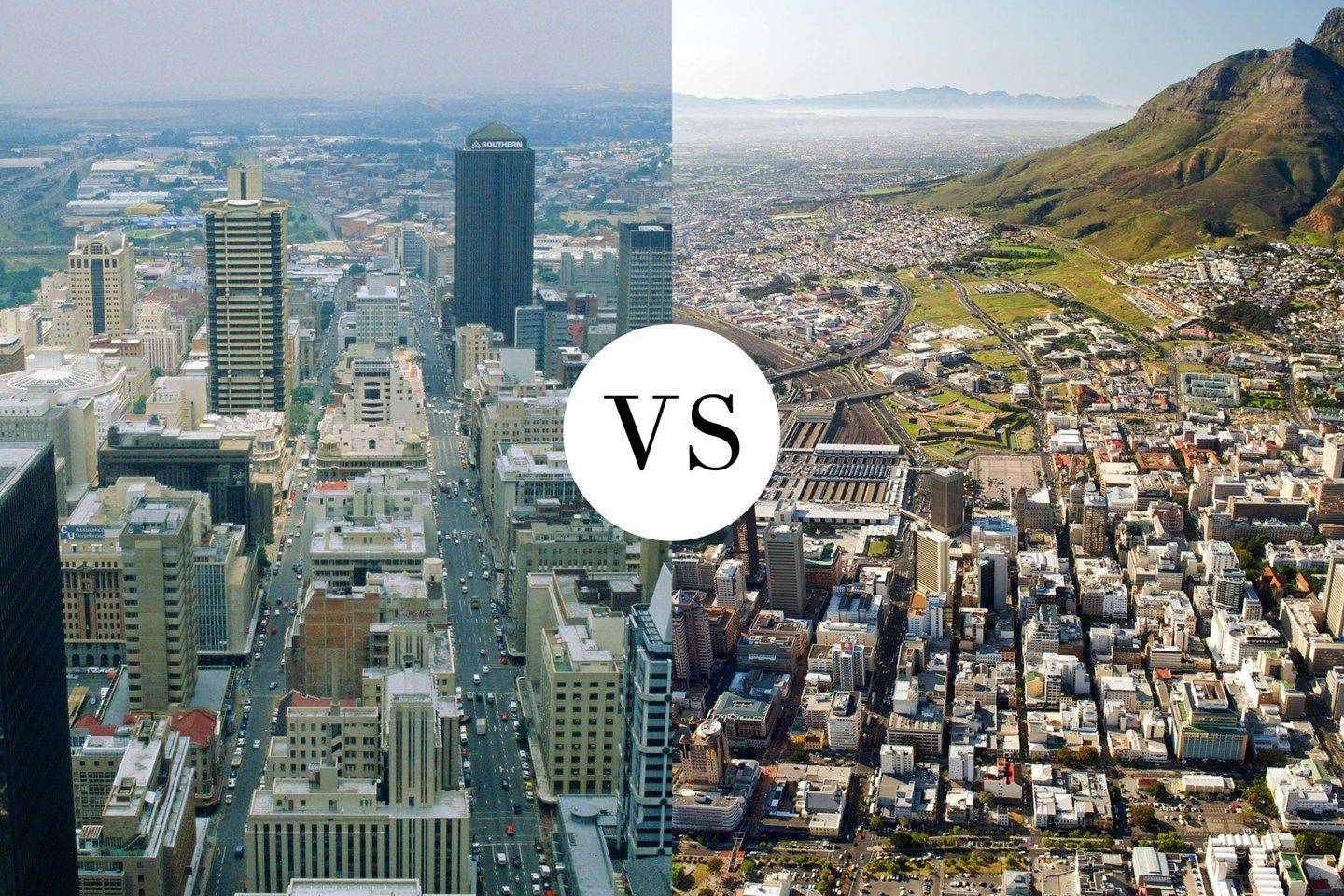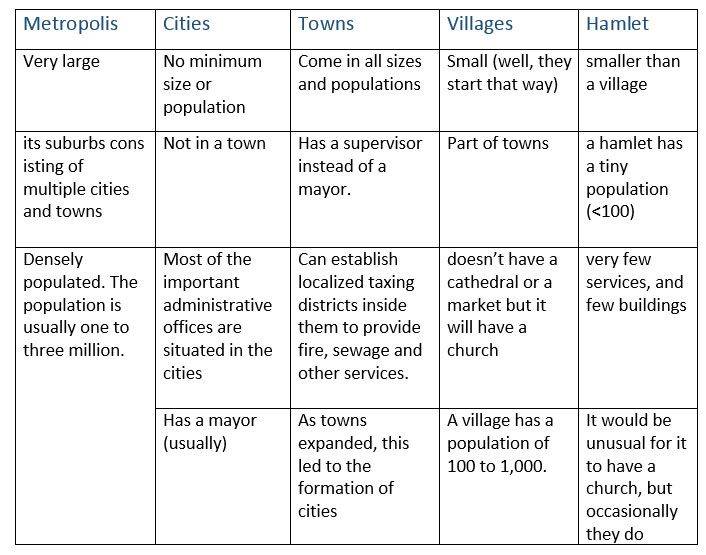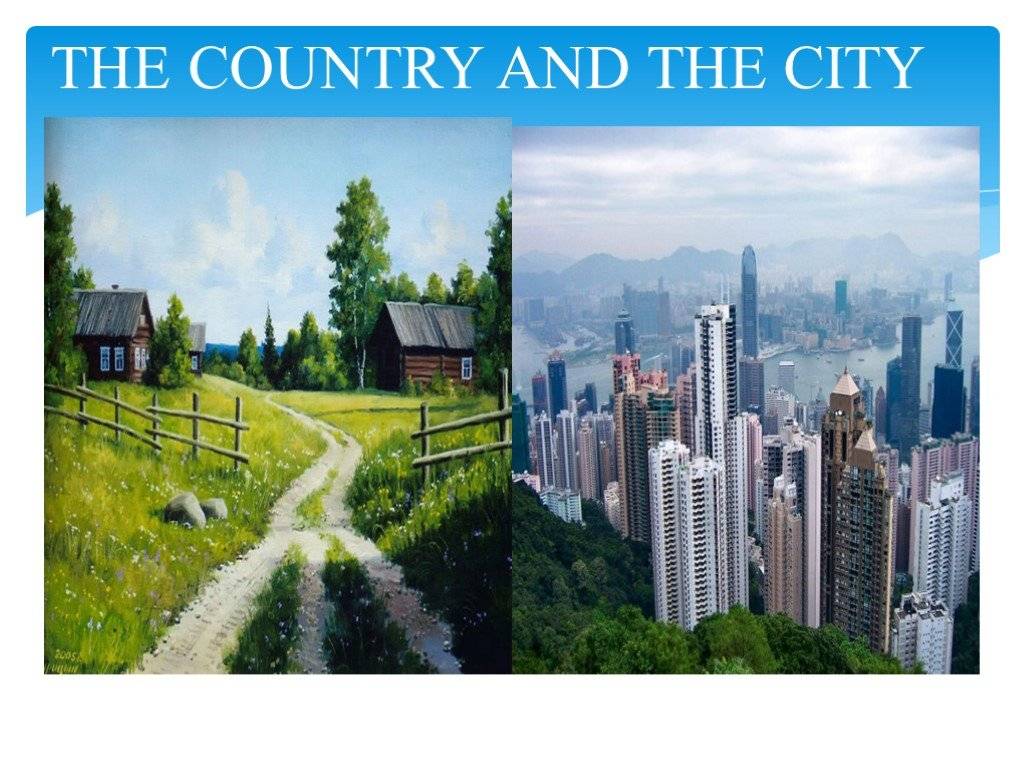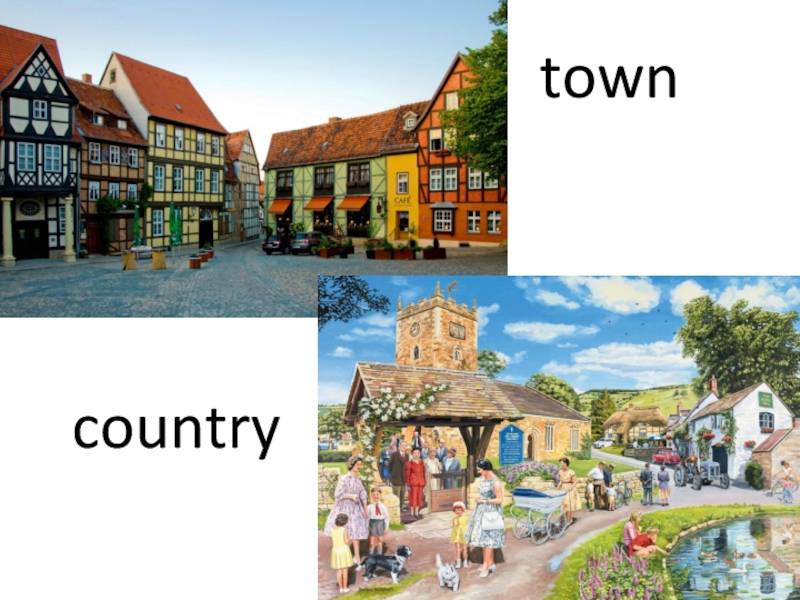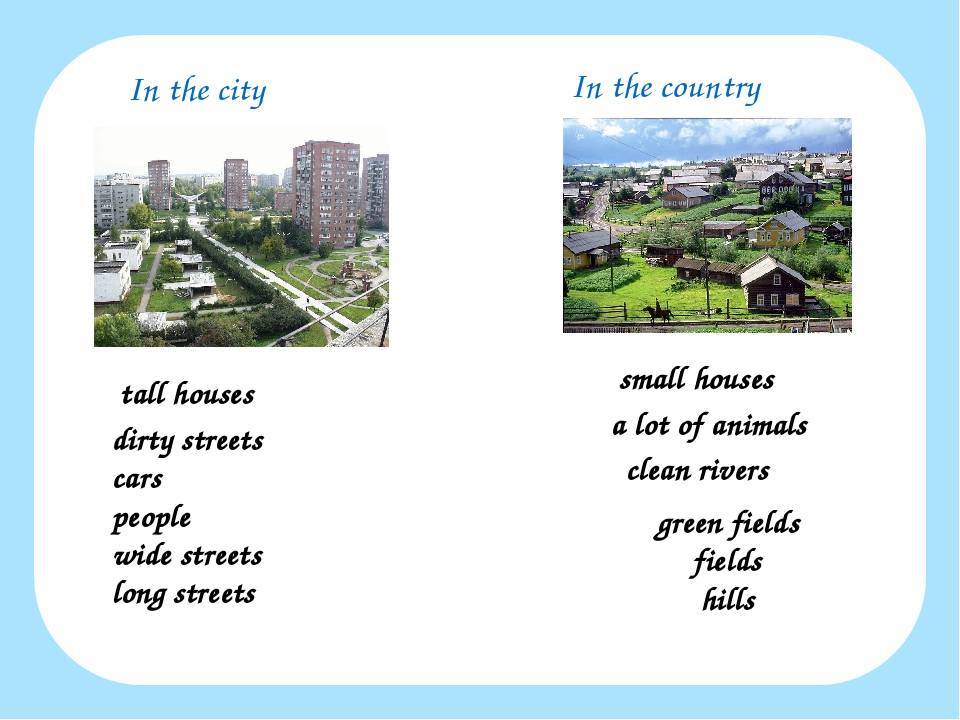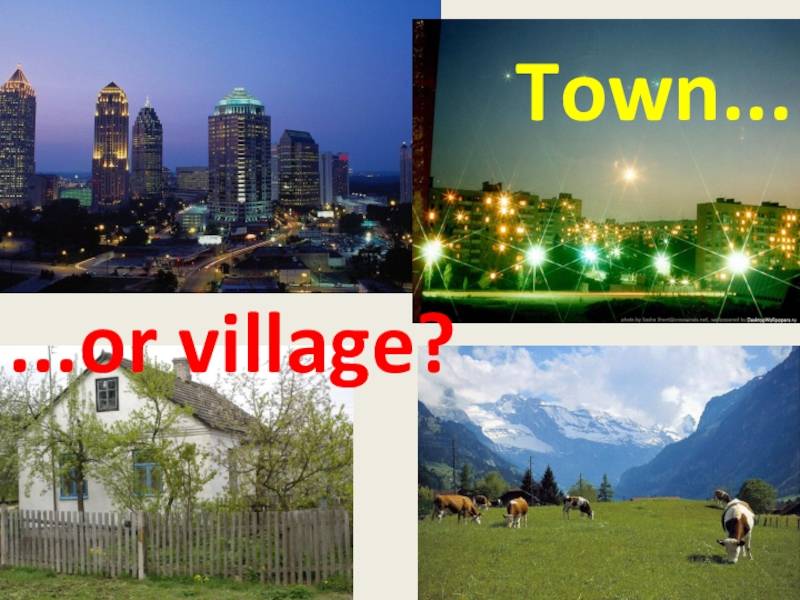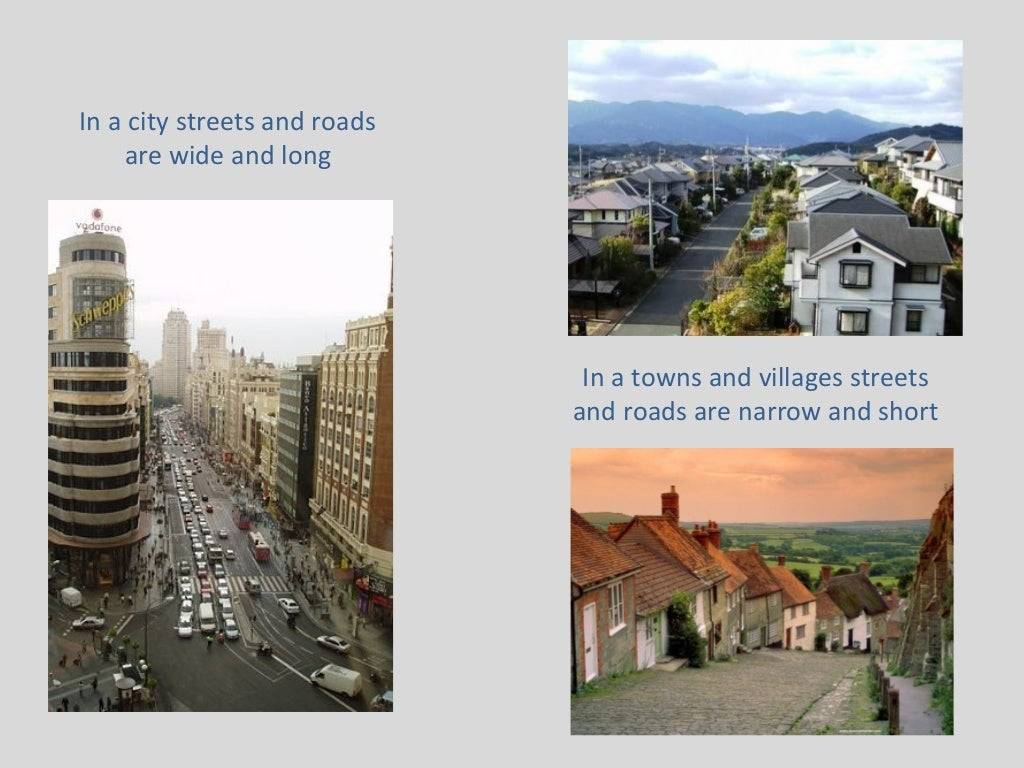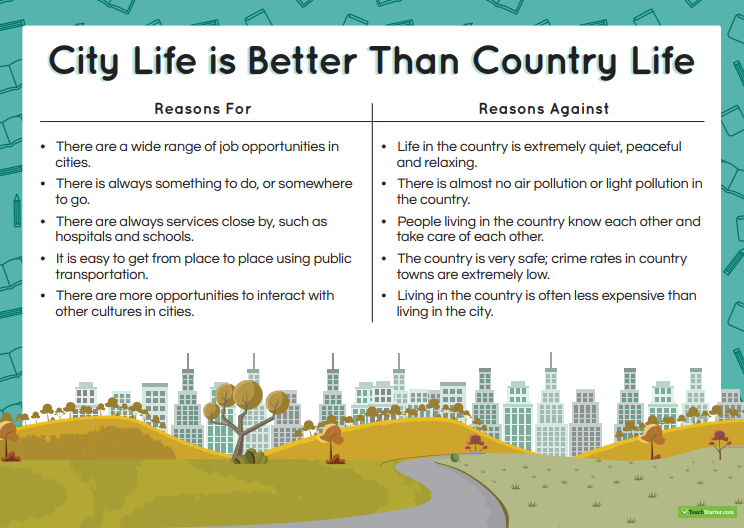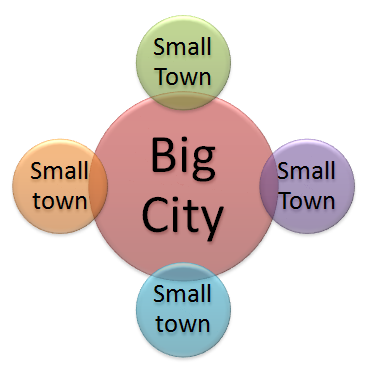Overview Of The Differences
Although towns and cities are urban centers, they generally differ by geographical size, population, and level of infrastructural development. The main difference between the two urban centers is that cities are much larger and more developed than towns. However, a place referred to as a city in one country may be a town or a settlement in another country and vice versa. For instance, a settlement with at least 200 people in Denmark or Sweden qualifies to be a town. Other countries like France do not distinguish between cities and towns and refers to the urban centers by common names like “villes.” In some countries like the United States, cities are legal entities with some degree of autonomy, while in other countries, they simply refer to large urban settlements.
Если говорить о населённом пункте
По общему правилу — city всегда больше, чем town, а town всегда больше, чем village. Кембриджский словарь даёт определение: city is a large town.
В Англии
Общая структура населённых пунктов в Англии:
- Village — деревня.
- Town — город.
- City — традиционно обозначает более крупный город, в котором есть кафедральный собор.
В США и Канаде
Общая структура населенных пунктов в США и Канаде:
- Town — город.
- City — крупный город.
В настоящее время в США, в отличие от стран Европы, практически не используется понятие village, и самые небольшие населённые пункты называются small town.
Словом village могут называться некоторые населённые пункты на северо-востоке США, основанные первыми переселенцами, например Hempstead в штате Нью-Йорк, а также традиционные поселения коренных народов Северной Америки.
Кроме того, слово village может использоваться компаниями для обозначения своего бизнеса. Например, Sunshine Village — это горнолыжный курорт в Канаде недалеко от Калгари.
В России
Для обозначения городов, являющихся центрами регионов Российской Федерации, и многих городов, являющихся районными центрами, наиболее подходит слово city.
В таких городах располагаются не только все виды государственных структур, но и промышленность, больницы, высшие учебные заведения, научные организации, развитая культурная среда.
Поселок городского типа, рабочий посёлок, село, районные центры такого типа — town.
Деревня, местечко, слобода, хутор — village.
Difference between cities and towns
While the terms town and city are often used interchangeably, towns are very different when compared with cities. It becomes little challenging to differentiate between cities and towns because some of the characteristics overlap between the two and there is no universally accepted definition as such.
1. Demographics and Geography
Cities have a high variation in the demographics which includes broader ranger of people with different races, languages and religions. compared to towns. Cities have much higher population density and have much larger area. On the other hand, towns are much smaller in size and have comparatively less population which is not highly diverse in nature.
2. Economy
It is clear that a large population leads to a booming economy. Most cities tend to have an excellent economy with a more considerable work force and buying capacity of the people. Thus, the large brands and entrepreneurs prefer to establish their businesses in cities rather than towns. Also, cities generally have a development plan that guides the growth of the city. However in towns, smaller economies exist which is not as highly active as the cities.
3. Governance
There is a huge difference in the cities and towns in terms of the governance and funds that helps in functioning of the urban form. That plays an important role as all the crucial decision related to the settlements and the residents are highly influenced by the same.
City Vs. Town
| City | Town |
| A city is an important center of commerce, economics and culture with its local laws and well-defined transport, housing and sanitation. | Towns are small group of human settlements that comprise of residencies placed closely for better cohesion and socialization. |
| A city is large enough to cover a wider area of land. | A town comparatively covers a smaller area of land. |
| According to the traditional view, cities initially started to form around the Neolithic era (10,000-4,500 BC). Examples of early cities are Ur, Sumer and the cities of the Indus Valley Civilization. | Towns began to appear in the initial stages of human history, most likely after the Stone Age era. |
Related:
- Sponge City
- Top 10 Things You Can Ask Your City Government To Do
- NEOM – The Future City, too Good to be True?
- Data requirements for planning a town
- What are ghost towns?
Tuesday, March 25, 2014
Наняли месяца четыре назад к нам в отдел QA Manager”а. То бишь руководителя над тестерами. Смуглый такой индус (потом оказалось, что он родом с Шри Ланки, но уже лет 17 живет в Канаде).
Посадили его за соседний стол. Как и многие индусы, он оказался очень важным. Ходил с записной книжечкой, с очень важным видом читал рабочую почту. На столе рядом с мониторами поставил свой диплом бакалавра каких-то там наук, полученный в университете в Оттаве.
Через время все заметили, что никакой особой работы мой сосед не делает. По часу шепотом говорит по рабочему телефону, долго и медленно читает каждый новый имейл, изучает профайлы на ЛинкдИн. И все бы ничего, но через время я заметил за ним то, с чем совершенно было невозможно ужиться.
Мой сосед беспощадно пердел. Изредка громко, а чаще бесшумно, но вонь стояла нестерпимая. Ситуация еще усугублялась тем, что сидел он между мной и окном, а от окна шли воздушные потоки системы отопления – и все в мою сторону. Сказать ему об этом прямо было как-то неудобно – он ведь мог начать отнекиваться, а я бы не смог доказать, что именно он портит воздух. В итоге я написал на всех сотрудников в нашей комнате письмо, мол, заметил я такую вот вонь, пожалуйста пожалейте коллег, пройдите 15 метров по коридору и в туалете портите себе воздух.
Индус был первым, кто начал громко смеяться с этого письма. Я еще надеялся, что он образумится, но через пару дней как раз во время моего обеда пуки повторились. Пришлось идти к вице-президенту. Тот меня выслушал, выразил свой шок и сказал, что если удастся в офисе выделить ему другое место – его пересадят.
Тем временем, сотрудники в отделе пытались найти объяснение такому поведению. Кто-то высказал мысль, что может быть это его культурная особенность, но контр-аргументом было то, что наш коллега прожил полжизни в Канаде, пора бы уже и усвоить местные традиции.
Как бы там ни было, можно долго искать объяснения и пытаться понять, но когда дышать невозможно, тогда уж не до объяснений – кислород заканчивается очень быстро. Ситуация развязалась как раз перед Рождеством. Моего соседа уволили быстро и неожиданно для всех, и в первую очередь для него самого. И даже несмотря на то, что он остался без работы, – мы в прямом смысле слова смогли вздохнуть с облегчением. Потому что с тех пор в нашем офисе никто не пукает:)
Comparison Table: 7 Key Differences Between Town And City
| Components | Town | City |
|---|---|---|
| Size | Towns are typically smaller than cities than in terms of population, geographical area, and infrastructure. | Cities are typically larger than towns in terms of population, geographical area, and infrastructure. |
| Density | Towns tend to be less densely populated than cities. | Cities tend to be more densely populated than towns, with higher concentrations of people living and working in smaller areas. |
| Infrastructure | Towns generally have less advanced infrastructure systems than cities, including public transportation, airports, hospitals, and other facilities. | Cities generally have more advanced and comprehensive infrastructure systems. |
| Economic activity | Towns often have less diverse job opportunities and higher average incomes. | Cities are often centers of economic activity, with more diverse job opportunities and higher average incomes. |
| Cultural diversity | Towns are less culturally diverse. | Cities tend to be more culturally diverse than towns. |
| Government structure | Towns may be governed by a select board, town meeting, or other forms of local government. | Cities are typically governed by a mayor and city council. |
| Social life | Towns may have a quieter, more tight-knit community feel. | The social life in cities can be more fast-paced and bustling compared to towns. |
City:
Pin
A large town.
Your browser does not support the audio element.
Generally, a city is considered to have the most important places in an area. It should have particular administrative, legal or historical status based on local law. Let’s see an example to make it clear to you how to use the word “city.” They need to install more city lights. From this statement, we might understand that, someone said that they want more city lights. Here we come up with another example for your reference. Do you enjoy city life? From this question, we might understand that someone asks whether he or she enjoys city life or not.
Enunciation:
Syllabification refers to the process of division of words into smaller parts. It is commonly known as syllables. With its help, you can easily read and spell the word accurately. Here, you will see how to split the word “City” by syllables.
- The word “City” has two syllables.
- It can be divided into “Cit-y.”
Using “City” in sentences:
- Do you have this city map?
- Oh my god, this is a vast city.
- Many of my relatives live in the city.
- Have you ever visited that city?
- You can see the whole city from this place.
What is a City?
A city is a place where you will get all the facilities and the perfect need for your lifestyle. If you are a good working professional or studied enough then, you will have a bright future in the city than staying in some sort of village or someplace.
It will have good schools, shops, and everything you need in one place. It is also used as a word to describe a large town.
In City, you will find the population to be higher. There will be many people because everyone comes there to live a better life, a better job, and a better education. It will be crowded with lots of people moving here and there.
Sometimes you will find these things to be very suffocating. But once you get used to this, then it won’t become a big problem for you. You will get used to these things and the lifestyle of the city you live in.
It will also have better transportation and living facilities. You don’t have to wait so long to commute from one place to another place. All you need to do is get ready and arrive at some bus stop or railway station, and everything will fall in place.
You will find all the hotels and restaurants open in cities all the time for travellers. You don’t have to starve, or you don’t have to find some places to eat. There will be many shops for you to decide on and have a portion of good food.
Common Mistakes and Misconceptions
When it comes to distinguishing between towns and cities, there are several common mistakes and misconceptions that people often make. Here are a few of them:
Believing that size is the only factor that distinguishes a town from a city
While it’s true that cities are generally larger than towns, size is not the only factor that distinguishes the two. In fact, there are many small cities and large towns, so it’s important to look at other factors as well, such as population density, local government structure, and economic development.
Assuming that all towns are rural and all cities are urban
While it’s true that many towns are located in rural areas and many cities are located in urban areas, this is not always the case. There are many towns that are located in suburban areas and many cities that have a mix of urban and rural areas within their boundaries.
Confusing villages with towns
A village is a small community within a rural area, while a town is a populated area with fixed boundaries and a local government. While villages and towns may share some similarities, they are not the same thing.
Assuming that all cities have skyscrapers and bustling downtown areas
While many cities do have skyscrapers and bustling downtown areas, this is not a requirement for a place to be considered a city. In fact, there are many small cities that have a more relaxed pace of life and a more suburban feel.
Urbanization Trends
Over the last few decades, urbanization has significantly transformed the way people live and work around the globe. More than 4 billion people currently reside in urban areas, and the United Nations estimates that, for the first time in history, more people live in cities than in rural areas since 2007.
As you explore urbanization trends, it is essential to understand the differences between cities and towns. Generally, cities have at least 50,000 inhabitants in contiguous dense grid cells (over 1,500 inhabitants per square kilometer). In contrast, towns are smaller in population and have a less dense geographic distribution.
One major trend shaping urbanization is the green planning of public spaces. As cities continue to grow, there is a greater emphasis on designing sustainable, environmentally friendly environments. This includes incorporating green streets, new corridors, and public spaces to support social life, reduce air pollution, and improve overall quality of life for inhabitants.
Demographic trends also play a crucial role in urbanization. As populations grow and shift, cities and towns must adapt to accommodate new residents while balancing economic, social, and political factors. This may involve upgrading infrastructure, expanding public transportation systems, and offering affordable housing options.
References
- https://journals.sagepub.com/doi/abs/10.1177/875687050902800402
- https://onlinelibrary.wiley.com/doi/abs/10.1002/mcda.342
Home – Travel – City vs Town: Difference and Comparison
Last Updated : 20 November, 2023
One request?
I’ve put so much effort writing this blog post to provide value to you. It’ll be very helpful for me, if you consider sharing it on social media or with your friends/family. SHARING IS ️
What Is City?
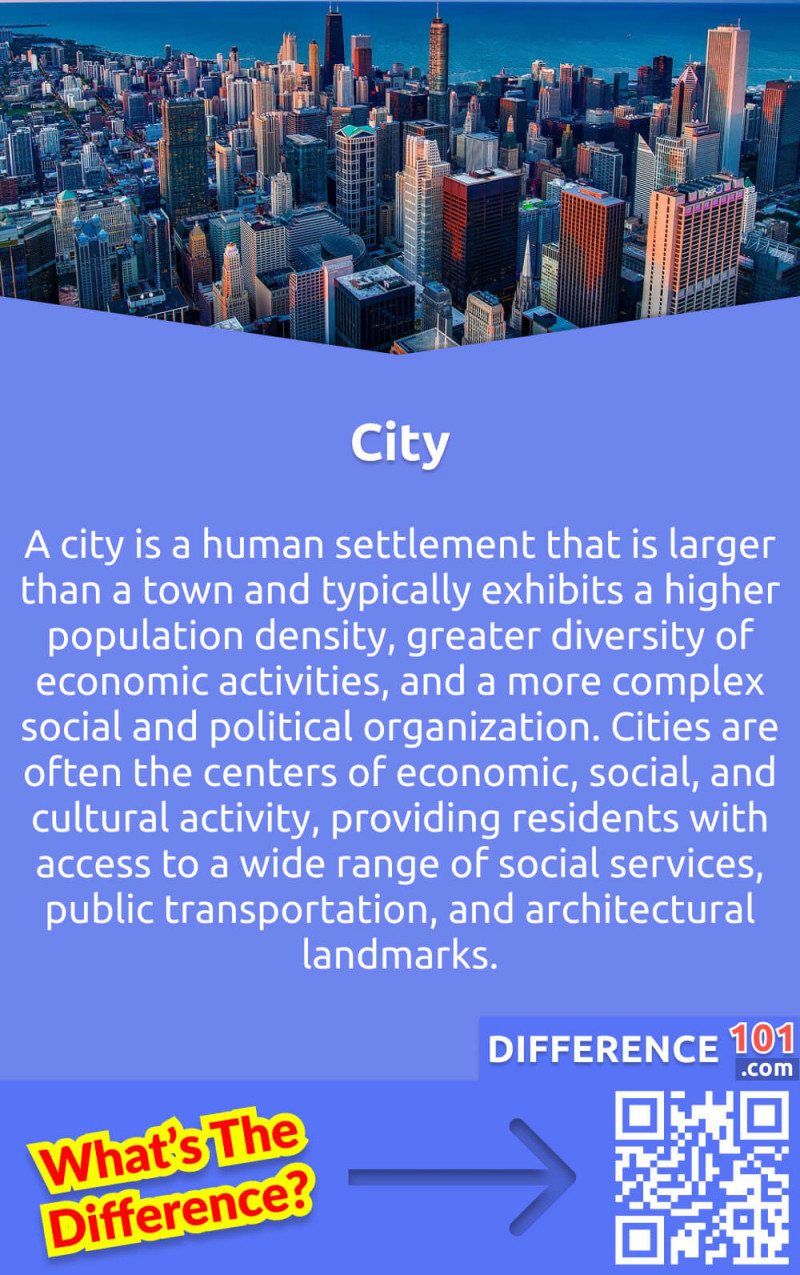
A city is a human settlement that is larger than a town and typically exhibits a higher population density, greater diversity of economic activities, and a more complex social and political organization. Cities are often the centers of economic, social, and cultural activity, providing residents with access to a wide range of social services, public transportation, and architectural landmarks. From bustling financial districts to lively residential neighborhoods, cities are characterized by their diversity of architecture, people, and ideas. The complex social and economic relationships in cities often give rise to complex political organizations, including municipal governments, city councils, and mayors. Ultimately, cities play a vital role in shaping and driving human society as we know it today.
FAQs
What is the difference between a city, town and village?
A city is typically a developed, densely populated urban area with a large population and more complex economic, social and infrastructure systems. Towns are typically smaller than cities but still have developed infrastructure, while villages are often rural areas with populations in the thousands or hundreds. Cities tend to be larger in terms of population size and density as well as economic activity. Towns may range from mid-size regional centers to small towns with fewer than 1000 inhabitants. Villages usually have fewer than 500 people and are usually based around an agricultural economy.
Are there examples of cities, towns and villages from different parts of the world?
Yes! There are many examples of cities, towns and villages from all over the world. For example, Shanghai is a megacity in China with over 24 million inhabitants, while Singapore is a modern, developed city-state. On the other hand, there are many smaller towns and villages around the world such as Florence, Italy, which has a population of about 400,000 people or Mønsted in Denmark which has only 600 inhabitants.
What makes cities different from towns and villages?
Cities are usually much larger than towns or villages and have more complex systems for transportation, communication and economic activity. Cities also tend to have higher population densities than either towns or villages as well as greater levels of diversity and cultural activities. Additionally, cities typically have better access to healthcare facilities, educational institutions and other services compared to smaller settlements.
How can I tell the difference between a city, town and village?
The easiest way to tell the difference between a city, town or village is by looking at the population size and density. Cities tend to have populations of over one million people while towns range from mid-size regional centers with up to 500 thousand inhabitants to smaller settlements of less than 1000 people. Villages are often rural areas with populations in the hundreds or thousands, depending on the region. Additionally, infrastructure development and economic activity can be used as indicators for distinguishing cities, towns and villages.
Сравнение
Кажется, все просто – если описываете мегаполис, используете city, маленький – town. Тем не менее путаница есть довольно серьёзная, и связана она прежде всего с различиями между английским и американским употреблением этих слов.
Для начала ознакомимся с правилами в Англии. Исторически существовал достаточно чёткий критерий: если в городе есть церковь (cathedral), это city, если нет – это town. Сегодня этот критерий сохраняется, за одним но: есть city без церквей.
И это определяется уже не грамматическими правилами, но решением правительства.
В Америке town – переходное между city и village. Последнее на наш язык в переводе означает «деревня»: чтобы называться так в Америке, населённый пункт обязан иметь менее 1000 жителей (или занимать не более 13км 2 площади), большая часть которых занимается сельским хозяйством.
В town от 1000 до 30000 жителей, и при этом практически нет многоэтажных домов – в основном одноэтажные домики. Однако это разграничение очень относительное, так как городской статус определяется довольно часто законами штата с учётом материальных представлений, так как если посмотреть на с юридической точки зрения, town и city выделяются по типу управления городом: city – это юридически определённое образование со всеми вытекающими отсюда полномочиями.
Что же делать нам? У нас и в небольших городах могут состоять многоэтажные дома, за счёт этого ориентироваться стоит на численность населения и развитость города.
И если речь идёт об областном или региональном центре – используйте city, если же вам требуется обозначить компактность – town.
What is a Town?
A town is a term used to describe smaller cities. Not all cities are big in this world. Some might be very small than what we have anticipated. In that case, they use this word to describe them. It will have all the basic facilities that are needed for a person to live.
In some villages, people will travel from their places to town to get a better job and education. But it will be a daily journey.
They will travel daily and will go back to their villages once the work gets over. But some people will also stay, but it depends on their comfort. It will have many people, but it won’t be very much crowded.
In town, you will be able to find all the necessary government offices, police stations, food centres, and big shops. Here you can buy whatever you want in a single place.
A town can also become a city if the population in that place increases. Because once the population increases, more facilities will be provided to that place. It will make that place grow.
More people will leave their villages to come here so that they can earn more than what they earned in their previous jobs. A town can also become famous if more people start speaking about that place.
It will make others curious, so they will visit that place, and some might decide to settle with their family.
Friday, November 29, 2013
Нет, никуда я не пропал, просто на какое-то время перестал писать в блог.
Началось все с того, что начальник моего отдела уволился, потому что нашел работу поинтереснее. А мы вдвоем раньше закрывали один участок работы, которым больше никто не занимался. После ухода шефа, кусок работы полностью лег на мои плечи.
С одной стороные это классно – на всю компанию я один занимался конвертацией данных из разных систем клиентов в нашу, и никто больше в этом вопросе не разбирался. Можно было не переживать о том, что могут уволить/сократить или не выплатить премию.
С другой стороны, через несколько месяцев я заметил, что работа начинает требовать больше времени, чем хотелось ей посвящать. А не делать ее нельзя – бизнес-процесс остановится. А потом стало еще интереснее – пара крупных клиентов начала активно переходить на нашу систему. И все бы ничего, но к этому моменту мне уже дали помощника. Который, что вполне логично, первые 2 месяца практически не помогал, а наоборот требовал еще больше моего времени, чтобы я его научил и он смог работать самостоятельно.
И только примерно к концу ноября появился просвет. Помощник помог разгрести завалы с мелкими клиентами, а крупных я разгреб сам.
Сейчас по инерции поезд поток работы еще прет, но ожидаю к середине декабря или к Рождеству снижения нагрузки до нормальной. Вот тогда можно вздохнуть спокойнее. И написать несколько постов о том, как прошло лето. Даже не прошло, а пролетело.
Но об этом попозже. До связи.
Conclusion
The main difference between a city and a town is population size. Cities are generally larger, more populated, and more diverse than towns. Cities tend to have more government services and higher taxes, while towns tend to have fewer amenities and lower taxes. Cities often have more shopping, entertainment, and cultural attractions than towns. Cities tend to be more densely populated, while towns are more spread out. Townspeople may be more likely to know each other, while city dwellers may be more likely to be strangers. Ultimately, the distinction between a city and a town is largely subjective and based on individual perception.
Town vs. City
Definition
Both towns and cities are types of human settlements. A town is a smaller settlement than a city and is usually located in a rural area. It has a smaller population and limited resources. On the other hand, a city is a larger settlement with a higher population density, more resources, and a more developed infrastructure.
Usage
The usage of the terms “town” and “city” varies depending on the country. In some countries, a town is a settlement with a population of fewer than 10,000 people, while in others, it can have up to 100,000 people. In the United States, a town is a political subdivision of a county, while a city is a self-governing municipality with a charter.
Key Differences Between Town and City
| Town | City |
|---|---|
| Smaller population | Larger population |
| Located in rural areas | Located in urban areas |
| Limited resources | More resources |
| Less developed infrastructure | More developed infrastructure |
| Lower population density | Higher population density |
As seen in the table, the main differences between a town and a city are the population size, location, resources, infrastructure, and population density.
Town
В отличие от первого термина, town обозначает сравнительно небольшой город. Раньше существовал основной критерий, который давал разъяснение, можно ли называть населенный пункт словом city. Если в городе не было церкви, то это мог быть только town. Сейчас это неактуально, и принадлежность города к той или иной категории определяется количеством населения и условиями жизни.
Это не значит, что если населенный пункт назван словом town, то в нем не будет ни единой высотки или крупного торгового центра. И все же разница вполне очевидна тем, кто бывал в городах с кардинально разным населением. Для людей, привыкших к сумасшедшему темпу жизни мегаполиса, размеренные будни жителей городов поменьше могут показаться и вовсе скучными
Но это обманчивое впечатление, ведь в каждом городе есть свое неповторимое очарование, и неважно, будет это Лондон или маленькая деревушка в его окрестностях. City, town – разница лишь в ритме жизни, комфортном лично для вас
Difference Between Town and City
Definition
A town is an urban area that is smaller than a city but larger than a village.
A city is a large urban area of greater size, population, or importance than a town or village.
A town has a lower population than a city.
A city is densely populated than a town.
Towns generally do not have advanced facilities as cities.
Cities have advanced facilities and utilities.
Size
A town is geographically smaller than a city.
A city is larger than a town.
Image Courtesy:
“London from a hot air balloon” by Daniel Chapma – Flickr. (CC BY 2.0) via
“St Mary’s Church, Castle Street 1” by Andrew Smith. (CC BY-SA 2.0) via
What’s a city?
Cities are larger human settlements. They are considered larger than towns and villages in both population, size, and degree of importance.
Many places in the world assign cities a special symbolic status known as city status. This status gives cities various legal distinctions and/or freedoms.
In the United States, most states require a minimum number of inhabitants to qualify as a city. The minimum number of citizens to qualify as a city in the US typically ranges between inhabitants.
The majority of cities in the US are incorporated municipalities, meaning they have a corporate status and set local government.
Cities are generally urban communities or urban areas (also referred to as urbanism).
 A conversation about towns, villages, and cities.
A conversation about towns, villages, and cities.
What is a Town?
As an expert on the topic of towns, we can tell you that a town is a human settlement that is smaller than a city but larger than a village. Typically, a town will have a central business district where people can purchase goods and services, as well as residential areas where people live.
Unlike cities, towns are often more connected to their rural surroundings and may have a greater amount of natural scenery nearby. In addition to its physical features, a town is characterized by a sense of community and social cohesion. People who live in towns tend to know their neighbors and take an active interest in local affairs.
Overall, a town can be a wonderful place to call home if you value being part of a tight-knit community with access to both urban amenities and natural beauty.
В Англии
В Великобритании правила по использованию этих двух слов немного отличаются от американского варианта, указанного выше. Town – поселение без церкви. Если в поселении, независимо от размеров нет хотя бы небольшой церквушки, то это место, скорее всего, будет town. City, как Вы уже поняли, это городок с церковью. Но, что самое интересное, встречаются и без церквей. Подобное всего лишь исключение из правил.
Присвоить месту без церкви этот статус может только правительство специальным документом. Делается это обычно по некоторым причинам, до конца неизвестным россиянам
Скорее всего, это связано с важностью поселения. Если поселение имеет жизненно важный смысл для государства, но, к сожалению, в этом поселении нет церкви, правительство закрывает на это глаза, присваивает ему статус City.
How To Properly Use City And Town In A Sentence
Most people working in towns and cities won’t end a day without mentioning these words in their conversations. But do they use these words the right way?
Well, provided you use them in the right context, you shouldn’t doubt yourself. Regardless, the sections below allow you to learn more.
How And When To Use The Word City
A city is a noun whose plural is cities. How you use this noun depends on what constitutes a city based on the standards of a particular country. In most countries, use the word city when you want to mean the following:
- Areas with large populations than towns
- Areas bigger than towns in terms of size and functions
- Most developed urban places in a country
- Areas that the government has conferred the city status
City Expressions
You’ll realize that this word features many expressions. Have you heard of the “dog city?” It is a term people use to describe a place with so many dogs. Other terms include city hall, city slicker, and much more.
How And When To Use The Word Town
The term town is a noun. More than one town refers to “towns.” Use this word when you mean the instances below:
- Urban settlement areas that are smaller than cities in size and population
- Areas under the governance of town councils
Town Expressions
Many words come from the term town. For instance, townspeople mean inhabitants of a particular town, painting the town red means to party, and a night on the town means some excellent and entertaining times away from home.
Другие значения town
Городская местность (в Англии)
Слово town может означать городскую местность в целом по отношению к сельской местности.
We have always lived in the town. — Мы всегда жили в городе.
We moved out of town last year. — В прошлом году мы переехали за город.
Население города
Слово town может означать группу людей, проживающих в городе. В этом смысле оно может использоваться для обозначения действий, в которое вовлечено всё население города сразу, например, политические или спортивные события.
The whole town is supporting our team. — Весь город поддерживает нашу команду.
Центральная часть города
Если рассматривать город состоящим из двух частей — деловой и жилой — то словом town можно обозначить деловую часть города по отношению к жилой.
Mark is going into town to do some shopping. — Марк собирается в город за покупками.
Место проживания и работы (в США и Канаде)
Словом town обозначают обычно место проживания или работы, то, где человек обычно проводит время. В этом смысле люди могут иметь два противоположных состояния: in town — находятся в этом месте, out of town — находятся вне этого места.
В этом смысле не имеет значения размер города
Важно то, находится ли человек где-то здесь или уехал
Susan is in town this week.
They are out of town this weekend.
Выводы сайт
- В Англии city – город с церковью, а также тот, которому был присвоен такой статус решением правительства. The City – деловой район Лондона.
- В Америке статус city определяется законами штата. В самом общем случае town – городок с числом населения от 1000 до 30000, заполненный преимущественно одноэтажными домами;
- Говоря о русских городах или городах неанглоязычных стран, выбирайте то или иное обозначение в зависимости от контекста: областной или региональный город – скорее city, в другом случае – скорее town.
Since the human creation, people used to live in groups or tribes, which are now called as societies. Mainly there are three places of residences currently known to us in terms of human settlements. Village, town and cities are the places of residences which are distinguished upon basis of population area and boundaries. Cities or village are easily differentiable as they are mostly opposite to each other. Although when it is about differentiating it between towns and cities, one can get confused and that is why these term are used interchangeably. Most prominently, one can differentiate between town and city as town is the urban area larger than village but smaller than city, whereas city is the largest urban area within town and village, which has best facilities.
Comparison Chart
| Town | City | |
| Definition | Town is the urban area larger than village but smaller than city. | City is the largest urban area than town and village, which has best facilities. |
| Area | Less | More |
| Population | Less | More |
| Facilities | Less | More |
What is Town?
Town is the urban area that has defined boundaries, and local government, it is larger than a village and generally smaller than a city. In a similar way it has better facilities than the village but lack as much as comfort and technology cities have. In a broader concept, there are several other parameters which make it decide that whether it is a city or a town. In different countries and cultures, towns have different classification so it can be the case that town in a particular country might classify as the city in the other country or vice versa. In many parts of the world, town is being identified on the basis of the population as in Utah the population of over 1000 living at a place is called city and the population less than this marks is called town. On the other hand, in India the area having population over 20,000 is identified as town, whereas areas with lesser population than this are called villages.
What is City?
City is the urban area which is largest in area as compare to the town and village. Similarly, cities have larger population and more facilities and places for leisure. In some countries a city is said to be the large town; large in terms of area and population, whereas it misses one of its prominent features of better facilities. Better roads, schools, job opportunities, sanitation system, transport are few of the salient features of the cities. All of these feature might also be available in the towns but they are not much as abundance and perfection as they exist in the cities. Cities also have larger population and economical stability and that is why they are recognized around the globe, like New York city, London, Delhi and others. Cities also have defined boundaries, and have better government system.
Town vs. City
- Town is the urban area larger than village but smaller than city, whereas city is the largest urban area than town and village, which has best facilities.
- Cities also have larger population and economical stability than the towns.
- In many parts of the world, town is being identified on the basis of the population as in Utah the population of over 1000 living at a place is called city and the population less than this marks is called town.
- Better roads, schools, job opportunities, sanitation system, transport are few of the salient features of the cities.
- Cities have more facilities than the towns.
- Generally, city is larger than town area wise.
Русский язык имеет на вооружении множество слов, которые обозначают населенные пункты разных типов. Это могут быть города, деревни, поселки и мегаполисы. А вот в английском языке есть два слова, которые переводятся одинаково. Это слова city и town, означающие в переводе “город”.
